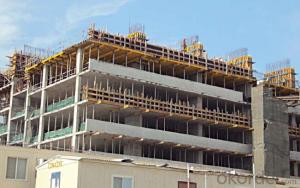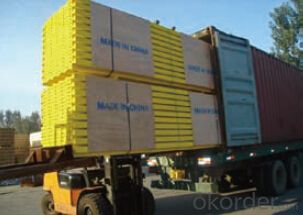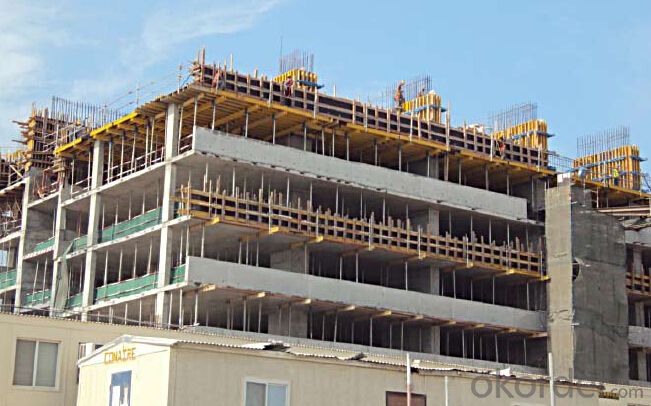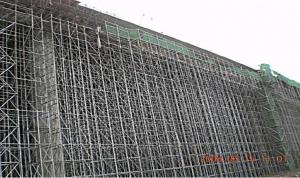Timber-beam formwork H20 for formwork and scaffolding systems
- Loading Port:
- Tianjin
- Payment Terms:
- TT OR LC
- Min Order Qty:
- 50 m²
- Supply Capability:
- 1000 m²/month
OKorder Service Pledge
OKorder Financial Service
You Might Also Like
Characteristics:
◆ Standardized production lines.
Supply capability: 3000m/day, Lmax = 6600mm.
◆ Finger jointing of the flange and web, the strength of timber beam is highly improved.
Max. shearing force failure load:40KN
◆ Well treated to prevent from water penetration or erosion, so the service life maximally
extended.
Normally, CNBM timber beam H20 can be used for 4 to 5 years, the exact using time would
depend on maintenance & storage.
◆ Robust caps at the end of the girders protect against damages.
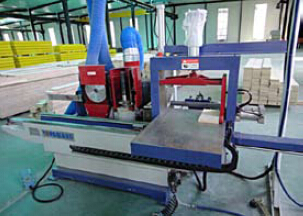
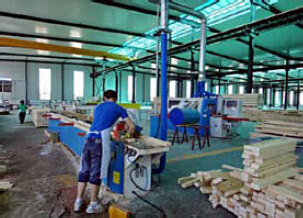
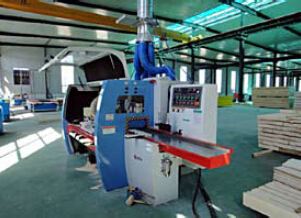
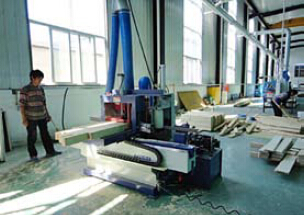
- Q: How does steel formwork affect the overall construction project management?
- The overall management of a construction project can be greatly influenced by the use of steel formwork. The following are several ways in which it can affect project management: 1. Enhanced time efficiency: Steel formwork is renowned for its durability and ability to be reused, resulting in time savings during construction. By properly planning and coordinating, steel formwork can be easily assembled and disassembled, thus facilitating faster progress in construction. This increased time efficiency can lead to improved project scheduling and overall project management. 2. Cost-effectiveness: Despite potentially having a higher initial cost compared to other formwork materials, steel formwork's reusability makes it a cost-effective choice in the long term. Consequently, project managers can allocate their budget more efficiently, reducing unnecessary expenses and ensuring that the project remains within the designated cost limits. 3. Quality control: Steel formwork provides a smooth and uniform finish to concrete structures. This enables project managers to maintain high-quality standards throughout the construction process. By utilizing steel formwork, project managers can ensure that the final product meets the required specifications and standards, thereby minimizing the need for rework and potential delays. 4. Safety and durability: Due to its strength and stability, steel formwork is a safe option for construction projects. Its robustness helps prevent on-site accidents and creates a secure work environment for construction workers. Additionally, the durability of steel formwork ensures its ability to withstand the pressures exerted during the concrete pouring process, reducing the risk of structural failures and subsequent rework. 5. Flexibility and adaptability: Steel formwork offers a high level of flexibility, allowing project managers to adapt to changes and modifications in construction plans. Whether it involves adjusting the formwork design or reusing the same formwork for different parts of the project, the flexibility of steel formwork enables project managers to promptly respond to unforeseen circumstances, thereby minimizing disruptions to the project. In conclusion, steel formwork significantly impacts overall construction project management by enhancing time efficiency, cost-effectiveness, quality control, safety, and flexibility. Its durability and reusability make it an invaluable asset for project managers, enabling them to deliver projects on time, within budget, and to the desired quality standards.
- Q: How is steel formwork supported during concrete pouring?
- During the pouring of concrete, steel formwork relies on a support system consisting of props, beams, and scaffolding. Props, which are vertical supports, are strategically positioned beneath the steel formwork to maintain stability and prevent any sagging or collapsing under the weight of the wet concrete. These props can be adjusted to achieve precise positioning and leveling of the formwork. In addition to props, horizontal beams are employed to provide additional support for the steel formwork. These beams are typically placed at regular intervals and connected to the props, creating a robust framework capable of withstanding the pressure exerted by the concrete. The beams also aid in distributing the load evenly across the formwork, ensuring its balance and security. Scaffolding is another essential component in supporting the steel formwork during concrete pouring. It is erected around the formwork to provide a secure working platform for workers to access and maneuver the formwork. Scaffolding also facilitates the installation and removal of the formwork, streamlining the construction process. In summary, the combination of props, beams, and scaffolding plays a crucial role in supporting steel formwork during concrete pouring. This support system ensures the stability of the formwork, allowing for accurate pouring and curing of the concrete, resulting in a structurally sound and long-lasting building.
- Q: How are steel formwork systems assembled and disassembled?
- A simple and efficient process is used to assemble and disassemble steel formwork systems. The process begins by erecting the steel panels, which interlock with each other using connecting devices like pins, wedges, or clips. These panels come in various sizes and shapes to meet different construction needs. To assemble the steel formwork system, the panels are aligned and connected based on the desired shape and dimensions of the structure. Pins or wedges are commonly used to secure the panels and prevent movement during concrete pouring. Once the panels are connected, support structures such as walers, props, and braces are installed. Walers are horizontal beams that connect the vertical panels, while props provide additional stability as adjustable vertical supports. Braces help resist lateral forces. During concrete pouring, the steel formwork system holds the wet concrete in place, giving shape and finish to the structure. After the concrete has cured and gained strength, the dismantling process begins. To disassemble the steel formwork system, the props and braces are removed first, followed by the walers. Once the support structures are taken down, the panels can be easily detached by removing the connecting devices. This can be done by pulling out pins or wedges or releasing clips. The disassembly process follows a systematic approach, starting from the top and moving downwards to ensure safety and prevent accidental collapse. It is important to follow safety guidelines and use appropriate tools to avoid damage to the formwork system or injury to workers. In conclusion, steel formwork systems are assembled by connecting panels and installing support structures, while the disassembly process involves removing support structures and disconnecting panels. This systematic approach ensures a safe and efficient construction process, allowing for the reuse of the formwork system in future projects.
- Q: How is steel formwork constructed?
- Steel formwork is constructed by assembling steel panels, beams, and props to create a sturdy framework. The panels are usually made of steel sheets with stiffeners and are connected together using various techniques such as bolts or clamps. The beams are placed horizontally and act as the primary support for the formwork system. Props are used to support the beams and distribute the load evenly. The steel formwork system is then adjusted and aligned to the desired shape and size, ensuring proper reinforcement and concrete pouring.
- Q: How does steel formwork handle concrete shrinkage and cracking?
- Steel formwork is a versatile and durable option for handling concrete shrinkage and cracking. It is designed to provide support and stability during the pouring and curing process, and its rigid structure helps to minimize the effects of shrinkage and cracking. One of the key advantages of using steel formwork is its ability to withstand the pressure exerted by the concrete as it shrinks. Steel is a strong and resilient material that can resist the forces generated by the drying and hardening of the concrete. This helps to prevent the formwork from deforming or collapsing under the weight of the shrinking concrete, ensuring that the structure remains intact. In addition, steel formwork is often equipped with expansion joints or other flexible elements that can accommodate the movement caused by shrinkage and cracking. These joints allow the formwork to expand and contract with the concrete, reducing the stress on the structure and minimizing the risk of cracks forming. Furthermore, steel formwork can be easily reinforced or supplemented with additional support elements, such as braces or tie rods, to further enhance its ability to handle concrete shrinkage and cracking. These reinforcements help to distribute the forces exerted by the shrinking concrete more evenly across the formwork, reducing the likelihood of localized cracking or structural failure. Overall, steel formwork provides a robust and reliable solution for managing concrete shrinkage and cracking. Its strength, flexibility, and ability to be reinforced make it an ideal choice for construction projects where minimizing the impact of these issues is crucial.
- Q: How does steel formwork affect the overall construction cost estimate?
- Steel formwork can have a significant impact on the overall construction cost estimate. While steel formwork may have a higher initial cost compared to other types of formwork, it offers several advantages that can offset this expense. Steel formwork is durable, reusable, and can be easily assembled and disassembled, resulting in reduced labor costs and increased efficiency. Additionally, steel formwork provides a smooth surface finish, which can minimize the need for additional surface treatments, saving both time and money. Overall, although steel formwork may require a higher upfront investment, its long-term benefits can lead to cost savings in the construction process.
- Q: Can steel formwork be used for both large and small construction projects?
- Yes, steel formwork can be used for both large and small construction projects. Steel formwork is highly versatile and can be adjusted to fit various project sizes. It offers durability, strength, and stability, making it suitable for both small-scale and large-scale construction projects.
- Q: What are the different types of accessories used in steel formwork systems?
- Steel formwork systems commonly utilize a variety of accessories to enhance support, stability, and usability during construction. One such accessory is the formwork prop, also called a shore or post, which is adjustable in height and provides vertical support for formwork panels or beams, effectively distributing the weight of the concrete. Another frequently employed accessory in steel formwork systems is the formwork beam, which horizontally supports formwork panels while adding strength and stability. Depending on project requirements, these beams can be made of steel or aluminum. Formwork clamps play a crucial role in steel formwork systems, ensuring secure connections between formwork panels or beams. Available in different sizes and designs, these clamps securely hold the formwork in place and accommodate various formwork configurations. Tie rods and wing nuts are also commonly used accessories, tightly securing formwork panels and preventing any gaps or leaks. By inserting tie rods through panel holes and tightening with wing nuts, a strong and secure connection is established. Furthermore, formwork brackets and supports are utilized to reinforce the formwork system and provide additional stability. These accessories are typically attached to the structure or scaffolding to hold the formwork securely. Other accessories, including formwork corners, wedges, and spacers, contribute to accurate and precise formwork placement and alignment. Overall, the diverse range of accessories employed in steel formwork systems serve multiple purposes, such as support, connection, reinforcement, and alignment. These accessories are crucial in creating a robust and dependable formwork system capable of withstanding the pressures and forces experienced during the concrete pouring process.
- Q: How does steel formwork handle different concrete surface treatments?
- Known for its versatility and durability, steel formwork excels in managing a range of concrete surface treatments. Its robust and inflexible structure enables it to withstand the pressure and weight of such treatments without distorting or collapsing. In construction projects that involve diverse surface treatments like smooth, textured, or patterned finishes, steel formwork is commonly employed. The steel panels and frames provide a stable and sturdy surface, ensuring an even pouring and curing of the concrete. This guarantees a consistent and high-quality finish. Furthermore, steel formwork readily adapts to different types of surface treatments. For example, if a project demands a smooth finish, the steel formwork can be polished or coated with a release agent to create the desired surface. On the other hand, if a textured or patterned finish is required, the steel formwork can be specially modified or designed to incorporate the desired texture or pattern. This flexibility allows for creative and customized results. Moreover, the reusability of steel formwork makes it cost-effective and environmentally friendly. It can handle a variety of concrete surface treatments across multiple projects, consistently delivering reliable outcomes. In conclusion, steel formwork is an exceptional choice for managing different concrete surface treatments due to its strength, durability, and versatility. It can withstand the weight and pressure of diverse finishes, adapt to various surface treatments, and be reused multiple times, making it a reliable and cost-effective option in construction projects.
- Q: What are the different types of lifting systems used in steel formwork?
- Steel formwork utilizes different types of lifting systems to meet specific requirements and ensure efficient and safe lifting operations. Some commonly used lifting systems include: 1. Crane lifting system: The most widely used system in steel formwork, cranes with various capacities are employed to lift and position formwork panels and components. They offer flexibility, high lifting capacity, and are suitable for large-scale construction projects. 2. Mechanical lifting system: This system employs mechanical devices like winches, hoists, or jacks to lift and position the formwork. It is ideal for smaller projects or areas inaccessible to cranes. Mechanical lifting systems are portable, user-friendly, and can be employed in confined spaces. 3. Hydraulic lifting system: Hydraulic systems use fluid pressure to lift and move the formwork. They provide precise control and are capable of handling heavy loads effortlessly. Hydraulic lifting systems are commonly used in high-rise buildings and projects that require smooth and controlled lifting. 4. Manual lifting system: In certain cases, manual lifting systems are used, especially for smaller formwork components or when machinery access is limited. This method involves utilizing manual labor to lift and position the formwork. It is cost-effective but requires more manpower and may not be suitable for larger or heavier formwork elements. 5. Pneumatic lifting system: Pneumatic lifting systems use compressed air to lift and move the formwork. They provide swift and efficient lifting operations and are suitable for projects with specific requirements, such as those involving hazardous materials or explosive environments. The choice of lifting system depends on various factors, including formwork size and weight, project requirements, available resources, and site conditions. Prioritizing safety measures, proper training, and supervision are crucial when utilizing lifting systems to prevent accidents and ensure smooth construction operations.
Send your message to us
Timber-beam formwork H20 for formwork and scaffolding systems
- Loading Port:
- Tianjin
- Payment Terms:
- TT OR LC
- Min Order Qty:
- 50 m²
- Supply Capability:
- 1000 m²/month
OKorder Service Pledge
OKorder Financial Service
Similar products
Hot products
Hot Searches
Related keywords

